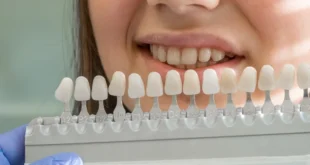Flossing
Often overlooked but crucial for oral health, plays a significant role in maintaining clean teeth and healthy gums. In this guide, we’ll explore the importance of flossing, how to do it correctly, and tips for various situations, from flossing with braces to teaching children the importance of this daily habit.
1. Steps for Proper Flossing:
Proper flossing technique is essential for effective plaque removal and gum health. Follow these steps:
- Take about 18 inches of dental floss and wind most of it around your middle fingers, leaving about 1-2 inches of floss to work with.
- Hold the floss tightly between your thumbs and index fingers, and gently glide it between your teeth using a back-and-forth motion.
- Curve the floss into a C shape around each tooth and carefully slide it under the gumline.
- Use a clean section of floss for each tooth, and don’t forget to floss the backside of your last molars.
2. Flossing with Braces:
Flossing with braces requires a bit of extra care to navigate around wires and brackets. Use a floss threader or orthodontic flosser to thread the floss under the wire and between teeth. Consider investing in a water flosser for easier cleaning around braces.
3. In Children:
Teaching children to floss from an early age sets the foundation for good oral hygiene habits. Use child-friendly floss picks or flossers designed for small hands. Supervise children until they can floss independently, usually around age 10.
4. When to Floss:
Flossing should be part of your daily oral hygiene routine, ideally done once a day, either before or after brushing. Flossing before brushing helps loosen plaque and debris, allowing the toothbrush to remove them more effectively.
5. Types of Floss:
There are several types of floss to choose from, including:
- Nylon Floss: Traditional nylon floss comes in waxed and unwaxed varieties and is suitable for most people.
- PTFE Floss: Also known as «glide» floss, PTFE floss is made of expanded polytetrafluoroethylene and slides easily between teeth, making it ideal for tight spaces.
- Dental Tape: Dental tape is broader and flatter than traditional floss, making it a preferred choice for people with wider tooth gaps or sensitive gums.
6.Tools:
In addition to traditional floss, various flossing tools can make the process easier and more effective:
- Floss Picks: Floss picks have a handle with a short piece of floss attached, making them convenient for on-the-go flossing.
- Interdental Brushes: Interdental brushes have small bristled heads designed to clean between teeth and around dental work like bridges and implants.
- Water Flossers: Water flossers use a stream of water to clean between teeth and along the gumline, making them an excellent alternative for people with braces or sensitive gums.
Flossing is a simple yet essential part of maintaining good oral hygiene. By following proper flossing techniques, using the right type of floss, and incorporating flossing into your daily routine, you can help prevent cavities, gum disease, and other dental issues, ensuring a healthy smile for years to come. Remember, a minute of flossing a day can keep dental problems away!
 Emprendedora en Calgary
Emprendedora en Calgary





